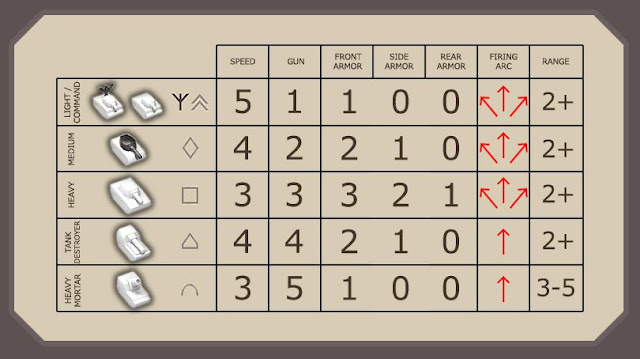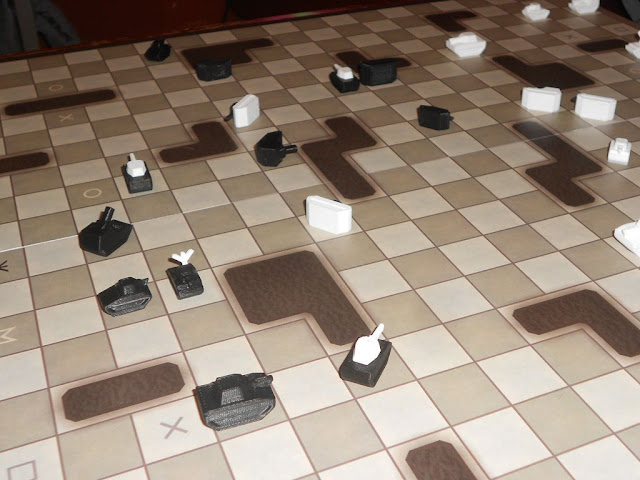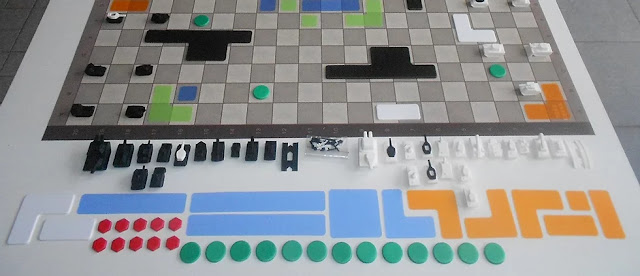GMT Games

Amazingly, the German U-Boat service during World War II suffered 75% casualties. 75%, let that sink in for a bit. The odds of playing Russian Roulette on the dock without bothering to go to sea are much better. One of the most decorated and prolific U-Boat commanders (Wolfgang Lüth) actually survived the war a whole seven days , and was shot by a German sentry on 5/14/1945.The other amazing thing about the North Atlantic Campaign was what were the Allies thinking! They had barely escaped World War I by using the Convoy System. So, in 1939 you would assume that the Convoy System would immediately be implemented once more. To one's astonishment, it was not. The worst time for Allied losses were just after the US entered the war. The U-Boat sailors called the first six months after Germany declared war on the US as the '2nd happy time'. One other item that is not well known about the undersea war was that the early German torpedoes were just as prone as the US ones regarding how many were duds. In the early part of the war the U-Boat's deck gun was more important than its torpedoes, not for self-defense, but to attack lone ships that they found. This being the third iteration of the game, let us find out what comes in the box:
Rules booklet w/ Designer notes
One full-color,2-sided countersheet
Four Player Aid Cards, 2-sided
U-Boat Combat Mat
Four U-Boat Display Mats, 2-sided
U-Boat Patrol Log Sheet
Three 6-sided, two 10-sided, one 20-sided dice
This is the write up by GMT Games about the Game:
8 German U-Boat types represented
9 Patrol Assignments
350+ named shipping targets
Special Missions for Abwehr Agent Delivery and Minelaying
Combat encounters with individual ships, ships with escort, convoys, and aircraft
Daytime and Night Engagement including wolfpack patrols
U-Boat Damage includes flooding, hull, torpedo doors, periscope,
fuel tanks, crew injury (by crew type), engines, hydrophones, flak gun(s), deck gun, batteries, radio
Crew Advancement, Commander Promotion including special decoration up to The Knight's CrossMulti-player and Tournament Rule options (including Wolfpack Tournament)
Evasive Maneuvers, Patrol Abort, Variable Escort Quality, Resupply at Sea, Gibraltar Passage, Reassignment to Newer U- Boat, Torpedo Duds, Random "Historical" Events, and much, much more!
The Hunters is a solitaire game of captaining a U-Boat in the years 1939-1943. Your goal is to complete missions and rack up Allied ship and tonnage loss. This is almost a role playing game about a U-Boat commander. As, or if, you complete missions you can be promoted in rank, and also win medals for your accomplishments. These are the U-Boats you can command in the game, and where you can patrol:
Type VII A
Type VII B
Type VII C
Type VII D
Type VII FlaK
Type IX A
Type IX B
Type IX C
Patrol Assignments include:
Atlantic
British Isles
Spanish Coast
Mediterranean
Norway
West African Coast
North America
Arctic
So next, let us look at the game's physical components. This game does not come with a map that will cover up two dining room tables. It also does not come with enough counters to equate one for one for an infantry battalion either. This game is all about information, and it makes sure that the player has a ton, and it is at his fingertips. The Rulebook is in color and is twenty-eight pages in length. This includes a historical briefing about the ten actual U-Boat commanders you can play as. In a nice touch that some games have, you also get a two page spread of the front and backs of all the counters. This is a great help with any mishaps that might occur. The print is smaller than I would like in a rulebook, however it is not GMT Games' fault that I am getting older. Another good design choice I am seeing more of, is that the Rulesbook has an Index on the back cover. The rules are much easier than would seem by their length. Once you have a game or two under your belt the game speeds along like clockwork. There are two 8-1/2"x11" maps. One is a copy of the official German Navy map with the coordinates shown just the way it was used in WWII. This map shows all of the areas of the North Atlantic and its environs that you can cruise in. The other map is the same size, but this continues down to Africa and South America. There are four double-sided pages/mats for each of the type of U-Boat you can command. Next, there are five Player's Aid pages for the Random Events, Encounter Chart, and Target rosters etc. These are all 8-1/2"x11" sized like the maps. The print on these is larger than the Rulebook, and they are also color coded for their use. The counters are 1/2" in size. These are nicely done and easy to read even with some of them having almost painting quality backgrounds. The game does come with a Patrol Log Sheet for the player to fill out. I know, boo hiss! These are my least favorite components in any game I come across. I have more than a few games where you have to keep track of your manpower for each division or whatever on a log. Definitely not my cup of tea as far as games go. I find them tedious and a real joy killer. I know, how much more is it of an onus to write down or mark a page than move a counter on a scale. For some reason it just irks me. However in this game it does not effect me at all. Because the game is more of a role-playing one, and you are listing your achievements, I do not have a problem with this log sheet. So, the components are up to GMT Games pretty high bar. Let us see what else we have.

This is the Sequence of Play:
1. DETERMINE PATROL ASSIGNMENT
A. Consult U-Boat Patrol Assignment Table
(7.0) [P1]
B. Enter patrol assignment on Log Sheet (on
row corresponding to patrol start date)
C. Place U-Boat Marker on Display Mat
beside first Travel Box of assigned patrol
2. CONDUCT PATROL
A. Check for encounters for Travel Box
occupied by consulting Encounter Chart
(8.0) [E1]. If no encounter occurs, repeat
this step for next Travel Box entered. If
encounter is rolled, follow steps below:
RESOLVE ENCOUNTER
a. Determine Random Event (if
rolled, 12.0), or resolve Air or
Ship Encounter (8.0). Engaging
enemy ships in combat is always
voluntary (8.1.4).
b. You may perform additional
rounds of combat as necessary
against unescorted ships (9.4.3) or
attempt to “Follow” escorted ships
or Convoys (9.7) until the encounter is completed, reloading torpedoes between instances.
c. Additional rounds of combat may
also occur should your U-Boat
be detected and undergo repeated
depth charge attacks. This cycle
repeats automatically until your
U-Boat escapes Escort Detection.
d. Attempt to Repair any Damaged
U-Boat systems once all combat rounds are completed (10.7).
Note: Following is still allowed
once you escape detection.
B. Proceed to next Travel Box and repeat
until U-Boat enters and resolves any
possible encounter for final Travel Box
(7.5). Upon completion, place U-Boat
marker in the In Port (Refit) Box.
3. REFIT U-BOAT
A. Assess U-Boat damage and duration
required (10.10) to complete all repairs
(record Refit duration on Log Sheet to
determine when next patrol will begin).
Note: if the next patrol start date is after
Jun-43, the game ends.
B. Check for Crew Recovery and possible
replacement (10.11).
C. Check for Crew Advancement (11.1).
D. Check for Kommandant Promotion and/
or Knight’s Cross Award (11.2 and 11.3).
E. Check for possible U-Boat Reassignment
(11.4).
F. Replenish and set Torpedo Loads (4.5)
and replenish Ammo markers (4.6) in
anticipation of next patrol. All damage
and crew injury markers should be
removed from the U-Boat Display Mat
in anticipation of next patrol assignment.
Because of the loss rate of U-Boats and sailors, the game keeps track of everything that might go wrong on a mission. A Submarine is a very complex machine of war, and could suffer myriads of problems even before you make contact with the enemy. These are some of the random events that you roll a dice for, once every patrol:
Man Overboard
Gyro Compass Fails
Torpedo Breaks Loose
"Hals und Beinbruch" - Literal meaning 'neck and leg break' slang for 'good luck'.
This is another situation where a game has been good enough to get me reading a lot more about the North Atlantic War. I knew the basics and a smattering of things, but certainly not the amount that I should have known about it. You have to understand that this is from someone who watched the director's cut of 'Das Boot' without a bathroom break! The game itself transcends wargames and really is more of a role playing game for the player. Like all the great games that go down to this level you, the player, become enmeshed with your cardboard warrior. As the years go by in your U-Boat you are forced to decide to go for the glory or just weather the storm and be content to survive until 1943. This is my first foray into the cardboard U-Boat world, but hopefully not my last. However, another game will have to be pretty good to want to make me consign this game to the shelf. Thank you GMT Games for another enriching and great gaming experience. I will be reviewing 'The Hunted' next from GMT Games. That follows the U-Boats from 1943-1945. You can continue with your U-Boat commander from this game or create anew.

GMT Games The Hunters:
Rulesbook, Errata, etc.:
GMT Games:
Robert
















































Follow Us